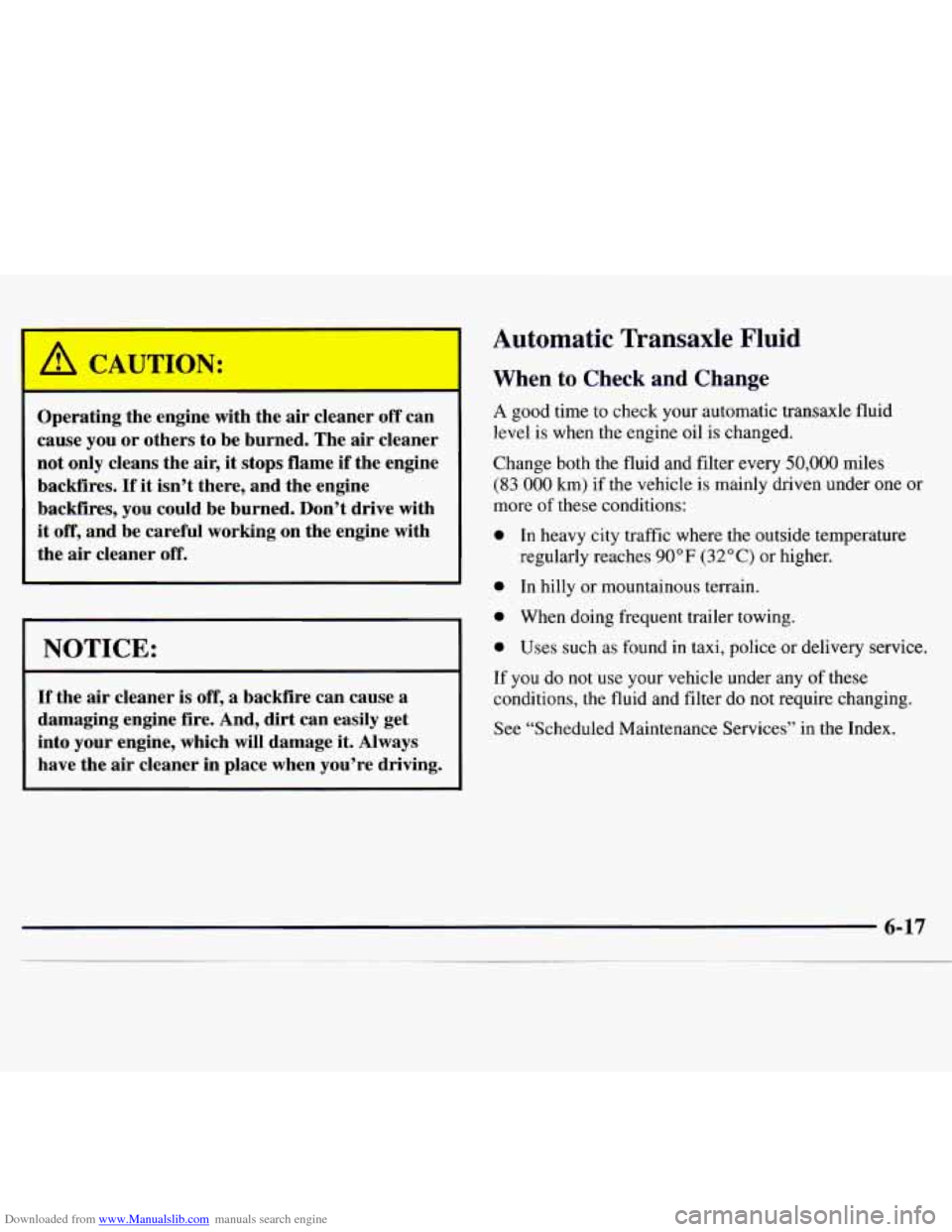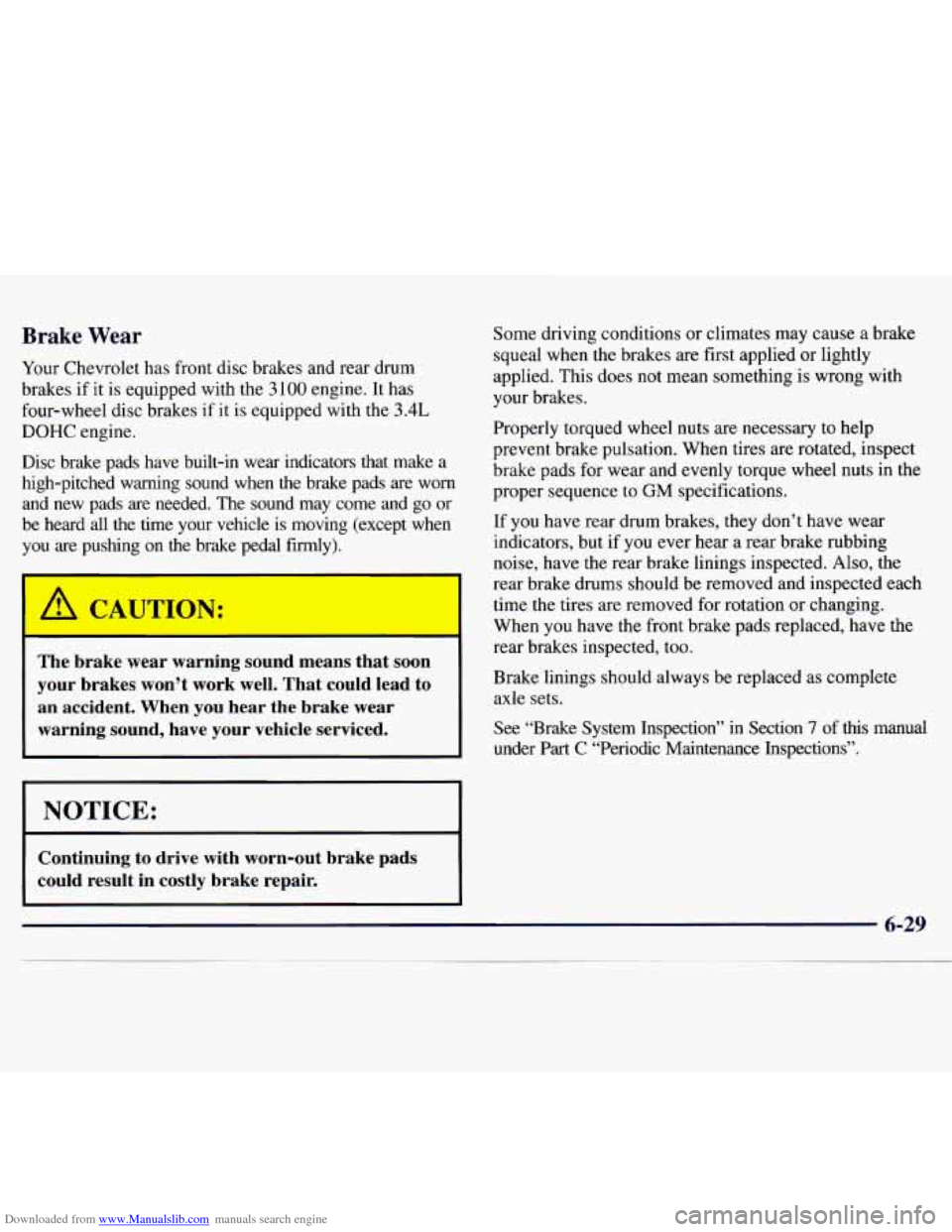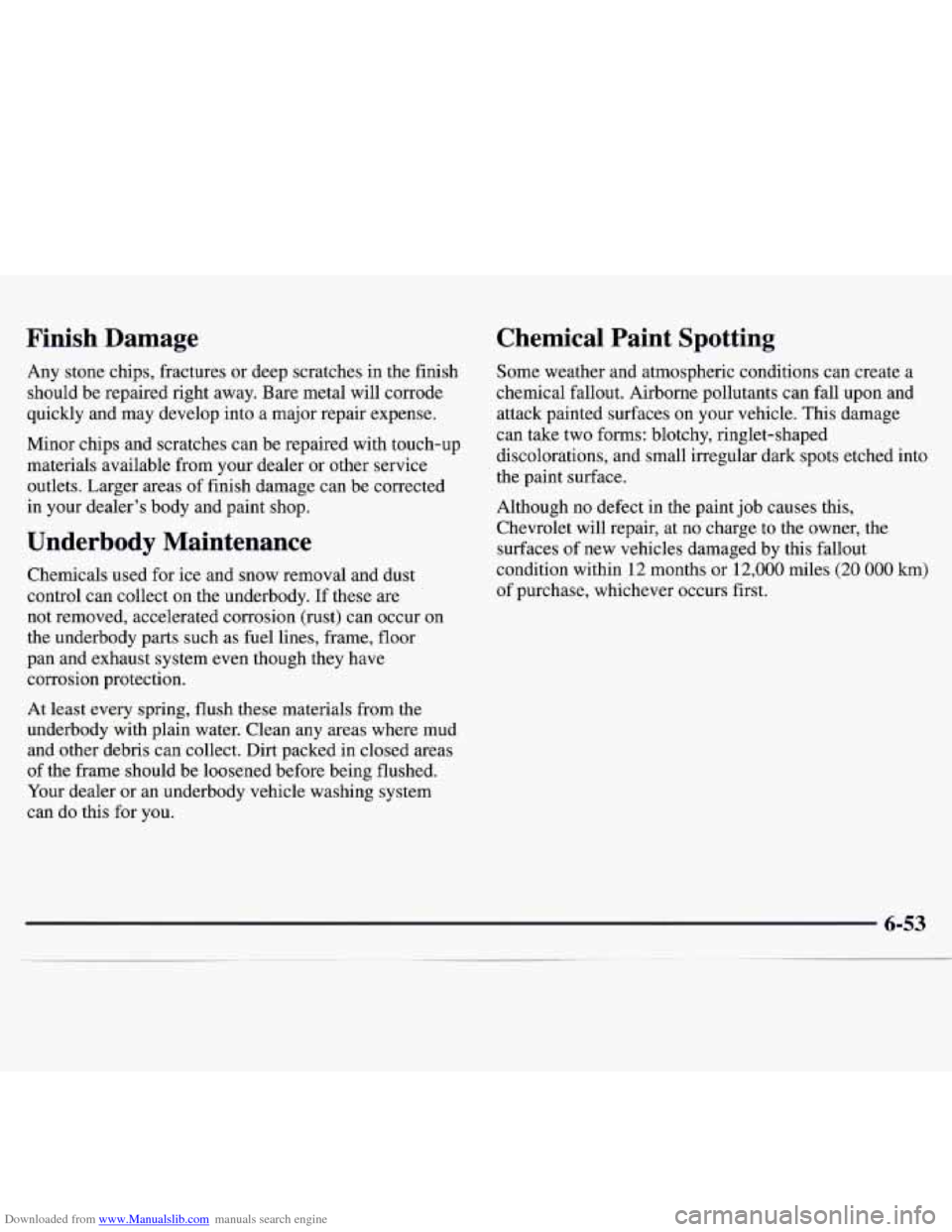Page 232 of 358

Downloaded from www.Manualslib.com manuals search engine r--
Operating the engine with the air cleaner off can
cause you or others to be burned. The
air cleaner
not only cleans the air, it stops flame if the engine
backfires.
If it isn’t there, and the engine
backfires, you could be burned. Don’t drive with
it off, and be careful working on the engine with
the air cleaner
off.
I NOTICE:
If the air cleaner is off, a backfire can cause a
damaging engine fire. And, dirt can easily get
into your engine, which will damage
it. Always
have the
air cleaner in place when you’re driving.
Automatic Transaxle Fluid
When to Check and Change
A good time to check your automatic transaxle fluid
level
is when the engine oil is changed.
Change both the fluid and filter every
50,000 miles
(83 000 km) if the vehicle is mainly driven under one or
more of these conditions:
0 In heavy city traffic where the outside temperature
regularly reaches
90°F (32°C) or higher.
0 In hilly or mountainous terrain.
0 When doing frequent trailer towing.
0 Uses such as found in taxi, police or delivery service.
If you do not use your vehicle under any of these
conditions, the fluid and filter do
not require changing.
See “Scheduled Maintenance Services” in the Index.
Page 235 of 358
Downloaded from www.Manualslib.com manuals search engine How to Add Fluid
Refer to the Maintenance Schedule to determine what
kind
of transaxle fluid to use. See “Recommended
Fluids and Lubricants” in the Index.
If the fluid level is low, add only enough of the proper
fluid to bring the level into the cross-hatched area on
the dipstick.
1. Pull out the dipstick.
2. Using a long-neck funnel, add enough fluid at the
dipstick hole to bring it to the proper level.
It doesn’t take much fluid, generally less than one
pint
(0.5 L). Don’t ovefill.
We recommend you use only fluid labeled
DEXRON@-III, because fluid with that label
is
made especially for your automatic transaxle.
Damage
caused by fluid other than DEXRON-III
is not covered by your new vehicle warrantv.
3. After adding fluid, recheck the fluid level as
described under “How to Check.’’
4. When the correct fluid level is obtained, push the
dipstick back in all the way.
Page 244 of 358

Downloaded from www.Manualslib.com manuals search engine Brake Wear
Your Chevrolet has front disc brakes and rear drum
brakes if it is equipped with the
3 100 engine. It has
four-wheel disc brakes if it is equipped with the
3.4L
DOHC engine.
Disc brake pads have built-in wear indicators that make a
high-pitched warning sound when the brake pads are worn and new pads
are needed. The sound may come and go or
be heard all the time your vehicle is moving (except when
you
are pushing on the brake pedal firmly).
I
The brake wear warning sound means that soon
your brakes won’t work well. That could lead to an accident. When you hear the brake wear
warning sound, have your vehicle serviced.
I NOTICE:
Continuing to drive with worn-out brake pads
could result in costly brake repair.
Some driving conditions or climates may cause a brake
squeal when the brakes are first applied or lightly
applied. This does not mean something is wrong with
your brakes.
Properly torqued wheel nuts are necessary to help
prevent brake pulsation. When tires are rotated, inspect
brake pads for wear and evenly torque wheel nuts in the
proper sequence to GM specifications.
If
you have rear drum brakes, they don’t have wear
indicators, but if
you ever hear a rear brake rubbing
noise, have the rear brake linings inspected. Also, the
rear brake drums should be removed and inspected each
time the tires are removed for rotation or changing.
When you have the front brake pads replaced, have the
rear brakes inspected, too.
Brake linings should always be replaced as complete
axle sets.
See “Brake System Inspection” in Section 7 of this manual
under
Part C “Periodic Maintenance Inspections”.
Page 254 of 358

Downloaded from www.Manualslib.com manuals search engine When to Check
Check your tires once a month or more.
Don’t forget your compact spare tire. It should be at
60 psi (420 kPa).
How to Check
Use a good quality pocket-type gage to check tire
pressure. You can’t tell
if your tires are properly inflated
simply by looking at them. Radial tires may look
properly inflated even when they’re underinflated.
Be sure to put
the valve caps back on the valve stems.
They help prevent leaks by keeping out dirt and moisture.
Tire Inspection and Rotation
Tires should be rotated every 6,000 to 8,000 miles
(10 OOO to 13 000 km). Any time you notice unusual wear,
rotate your tires as soon as
possible and check wheel
alignment.
Also check for damaged tires or wheels. See
“When It’s Time for New Tires” and “Wheel
Replacement” later in
this section for more information. The
purpose
of regular rotation is to achieve more
uniform wear
for all tires on the vehicle. The first
rotation
is the most important. See “Scheduled
Maintenance Services’’ in the Index for scheduled
rotation intervals.
When rotating your
tires, always use the correct rotation
pattern shown here.
Don’t include the compact spare tire in your
tire rotation.
Page 268 of 358

Downloaded from www.Manualslib.com manuals search engine Finish Damage
Any stone chips, fractures or deep scratches in the finish
should be repaired right away. Bare metal will corrode
quickly and may develop into a major repair expense.
Minor chips and scratches can be repaired with touch-up
materials available from your dealer or other service
outlets. Larger areas
of finish damage can be corrected
in your dealer’s body and paint shop.
Underbody Maintenance
Chemicals used for ice and snow removal and dust
control can collect
on the underbody. If these are
not removed, accelerated corrosion (rust) can occur on
the underbody parts such as fuel lines, frame, floor
pan and exhaust system even though they have
corrosion protection.
At least every spring, flush these materials from
the
underbody with plain water. Clean any areas where mud
and other debris can collect. Dirt packed in closed areas
of the frame should be loosened before being flushed.
Your dealer or an underbody vehicle washing system
can do this for you.
Chemical Paint Spotting
Some weather and atmospheric conditions can create a
chemical fallout. Airborne pollutants can fall upon and
attack painted surfaces on your vehicle. This damage
can take two forms: blotchy, ringlet-shaped
discolorations, and small irregular dark spots etched into
the paint surface.
Although no defect in the paint job causes this,
Chevrolet will repair, at no charge to the owner, the
surfaces of new vehicles damaged by this fallout
condition within
12 months or 12,000 miles (20 000 km)
of purchase, whichever occurs first.
Page 280 of 358

Downloaded from www.Manualslib.com manuals search engine Normal Maintenance Replacement PC.?-
Air Cleaner Filter
Battery
3100 (Code M) ....................... 600 CCA
3.4L DOHC (Code
X) ................. 690 CCA
Engine Oil Filter
3100(CodeM) .......................... PF47
3.4L DOHC (Code
X) .................... PF51
PCV Valve
3100 (Code M) ....................... CV892C
3.4L DOHC (Code
X) ................. CV895C
Radiator Cap
All Engines ............................. RC27
Spark Plugs
3100 (Code M) ........................ .41-940
Gap: 0.060”
(. 152 cm)
3.4L DOHC (Code
X) .................. .41-919
Gap:
0.045” (. 1 14 cm)
All
Engines
........................... A1208C
Vehicle Dimensions
Wheelbase .............. 107.5 inches (273 .O cm)
Tread Width (Front)
........ 59.5 inches (15 1.2 cm)
Tread Width (Rear)
........ 59.0 inches ( 150.0 cm)
Length
................. 200.7 inches (509.9 cm)
Width
................... 72.5 inches ( 184.2 cm)
Height..
................. 53.8 inches (136.8 cm)
Air Conditioning Refrigerants
Not all air conditioning refrigerants are the same.
If the air conditioning system in your vehicle needs
refrigerant, be sure the proper refrigerant is used.
If you’re not sure, ask your Chevrolet dealer.
Page 282 of 358
Downloaded from www.Manualslib.com manuals search engine Section 7 Maintenance Schedule
This section covers the maintenance required for your Chevrolet. Your vehicle needs these services to retain its safety,
dependability and emission control performance.
7-2
7-2 7-3
7-4
7-4
7-4
7-37
7-37
7-37 7-38
7-38
Introduction
Your Vehicle and the Environment
How This Section is Organized
Part A: Scheduled Maintenance Services
Using Your Maintenance Schedule
Selecting the Right Schedule
Part B: Owner Checks and Services
At Each Fuel
Fill
At Least Once a Month
At Least Twice a Year
At Least Once
a Year
7-41
7-41
7-4
1
7-4 1
7-4 1
7-42
7-44
Part C: Periodic Maintenance Inspections
Steering, Suspension and Front Drive
Axle
Boot and Seal Inspection
Exhaust System Inspection
Radiator and Heater Hose Inspection
Throttle Linkage Inspection
Brake System Inspection
Part D: Recommended Fluids
and Lubricants
Part E: Maintenance Record
7-1
Page 283 of 358
Downloaded from www.Manualslib.com manuals search engine LE
IMPORTANT.
KEEP ENGINE OIL
AT THE PROPER
VEL AND CHANGE
RECOMMENDED
AS
Have you purchased the GM Protection Plan? The Plan
supplements
your new vehicle warranties. See your
Warranty and Owner Assistance booklet, or your
Chevrolet dealer for details.
Introduction
Your Vehicle and the Environment
Proper vehicle maintenance not only helps to keep your
vehicle in good working condition, but also helps the
environment. All recommended maintenance procedures
are important. Improper vehicle maintenance can even
affect the quality
of the air we breathe. Improper fluid
levels or the wrong tire inflation can increase the level
of emissions from your vehicle. To help protect our
environment, and to keep your vehicle in good
condition, please maintain
your vehicle properly.